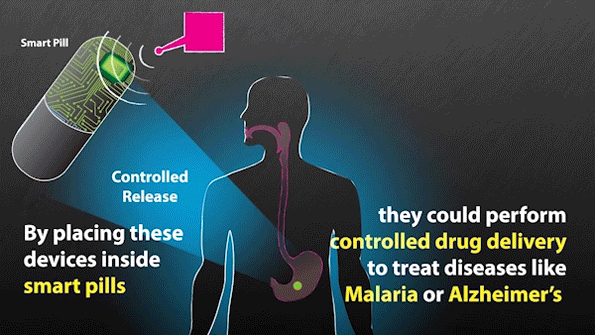
[Image above] Credit: Massachusetts Institute of Technology
Remember “Fantastic Voyage?”
It was a 1960’s movie about a scientist who invented a way to shrink humans and other objects for short periods of time. After he developed a blood clot in his brain from being attacked in Russia, a submarine containing a group of scientists is miniaturized and injected into his bloodstream—with a goal of fixing the clot before they return to normal size in one hour.
We may have just come a little bit closer to that science fiction story.
Researchers from Massachusetts Institute of Technology, Harvard Medical School, and Brigham and Women’s Hospital (BWH) have developed a technology to power tiny implantable devices that could be used to monitor medical conditions or treat diseases from inside the human body. The technology uses radio waves, rather than batteries, to power and communicate with the devices.
“Having the capacity to communicate with these systems without the need for a battery would be a significant advance,” assistant professor at BWH, Harvard Medical School, and research affiliate at MIT’s Koch Institute for Integrative Cancer Research Giovanni Traverso explains in an MIT news release. “These devices could be compatible with sensing conditions as well as aiding in the delivery of a drug.”
According to the researchers, radio waves are preferable to batteries to power implantable devices because batteries take up space. Therefore the devices can be made small enough to ingest or implant inside a human.
But radio waves have never been a useful technology for this type of application, as they typically break up when passing through the body. The researchers solved this issue by using In-Vivo Networking—a series of antennas that emit different radio wave frequencies that can provide enough power when they overlap at their peaks.
“We chose frequencies that are slightly different from each other, and in doing so, we know that at some point in time these are going to reach their highs at the same time,” assistant professor in MIT’s media lab and senior author of the team’s paper Fadel Adib says in the release. “When they reach their highs at the same time, they are able to overcome the energy threshold needed to power the device.”
After testing the system in pigs, the researchers found that they could power the devices from up to one meter (three feet) from the body to a sensor that was implanted 10 centimeters (around four inches) inside the body, according to the release. When implanted closer to the skin, the researchers found they could power the device from up to 38 meters (around 125 feet) away.
The researchers continue to work on increasing efficiency and travel distance of the system and will present a paper on their findings at a conference in August.
Their research opens up multiple opportunities for medical applications, including delivering drugs to patients through smart pills to treat diseases, measuring organ and tissue conditions, or treating brain and other neurological diseases.
That’s a lot more efficient than shrinking an actual person to do the job.
Watch the video to learn more about this new technology.
Credit: Fadel Adib, YouTube
Did you find this article interesting? Subscribe to the Ceramic Tech Today newsletter to continue to read more articles about the latest news in the ceramic and glass industry! Visit this link to get started.
